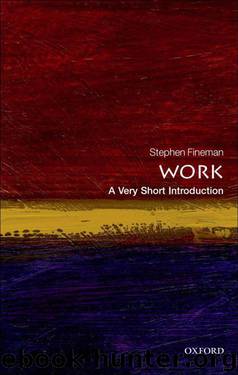Work: A Very Short Introduction (Very Short Introductions) by Fineman Stephen

Author:Fineman, Stephen [Fineman, Stephen]
Language: eng
Format: mobi, epub
Publisher: Oxford University Press
Published: 2012-11-28T16:00:00+00:00
Chapter 6
Emotion at work
It should not seem strange that work involves emotions. Yet, until relatively recently, academic portrayals of work life were reticent about emotion. Emotion was often sanitized in terms such as attitudes, preferences, and satisfactions. Strong emotions, especially, were seen to impede the smooth running of the rational enterprise, like sand in the organization’s machinery. In the late 1940s, social theorist Max Weber noted that it was the very absence of emotion that sustained the ‘ideal’ bureaucracy. Bureaucracy develops, Weber wrote, ‘the more perfectly … the more it is “dehumanized”, the more completely it succeeds in eliminating from official business love, hatred, and all purely personal, irrational, and emotional elements which escape calculation’.
Weber’s portrayal of an emotion-free bureaucracy summons up images of bureaucrats located in the offices (bureaux) of public and private organizations, impersonally and dispassionately applying administrative rules. Rarely can a complex organization be sustained without some bureaucratic control, which, at best, ensures fairness, consistency, and impartiality. However, it is its worst features that are remembered most, where set procedures and rules become ends in themselves. They are ingrained in totalitarian organizations and states, where obsessive bureaucracy stifles creative energy, discretion, and individuality, suppressing the very passions that human beings live and work by. A flourishing organization works with, not against, emotion.
Emotions can be seen as an indelible feature of working life, the prime medium through which we act and relate to one another, shaping and lubricating an organizational order. Feelings such as pride, joy, happiness, trust, love, and excitement, as well as fear, shame, anxiety, guilt, anger, and sorrow, are fundamental to what we do. They are implicated in how hard or reluctantly we work, how close or distant we are from our colleagues or bosses, and how committed or indifferent we are to our jobs.
An emotionful work life does not mean an emotion free-for-all. Emotion work permeates daily experiences. It is the constant interplay or tension between what we subjectively feel and what we can show or express—to whom, when, and where. Culture—societal and organizational—plays a pivotal role here. It frames how we should act and defines the currency of the socioemotional economy: the emotions we exchange to sustain or reset social bonds—a hand on the shoulder, a note of praise or compassion, a disapproving glance, a statement of appreciation, a hug or embrace. How masculinized or feminized is the setting? How interpersonal or impersonal is the work? How hierarchical or egalitarian is it?
Different physical zones of the workplace add materially to the emotion mosaic. The committee rooms, the corridors, the water cooler, the washrooms are, through quiet social consensus, invisibly coded to permit different degrees of frankness, disclosure, confession, or venting. Managing emotion is a fine-tuned human skill where context matters. A theatre company, engineering factory, hospital, army regiment, or police academy have contrasting emotion norms to which new members are socialized, and which, over time, are tested. Until recently, homosexuality in the American armed forces was handled on a ‘don’t ask don’t tell’
Download
Work: A Very Short Introduction (Very Short Introductions) by Fineman Stephen.epub
This site does not store any files on its server. We only index and link to content provided by other sites. Please contact the content providers to delete copyright contents if any and email us, we'll remove relevant links or contents immediately.
The Leavers by Lisa Ko(6505)
Born to Run: by Christopher McDougall(6298)
iGen by Jean M. Twenge(4714)
Sapiens by Yuval Noah Harari(4574)
The Kite Runner by Khaled Hosseini(4502)
Spare by Prince Harry The Duke of Sussex(4242)
Bullshit Jobs by David Graeber(3200)
Livewired by David Eagleman(3152)
Goodbye Paradise(2997)
Never by Ken Follett(2928)
A Dictionary of Sociology by Unknown(2526)
Harry Potter 4 - Harry Potter and The Goblet of Fire by J.K.Rowling(2426)
The Club by A.L. Brooks(2396)
People of the Earth: An Introduction to World Prehistory by Dr. Brian Fagan & Nadia Durrani(2357)
Machine Learning at Scale with H2O by Gregory Keys | David Whiting(2343)
The Social Psychology of Inequality by Unknown(2329)
Harry Potter and the Order of the Phoenix (5) by J.K. Rowling(2246)
Harry Potter and the Deathly Hallows (7) by J.K. Rowling(2243)
0041152001443424520 .pdf by Unknown(2238)
